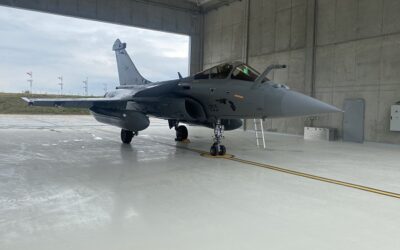2018 Space & Missile Defense Symposium Day 1 (7 August )
As announced this 13 June and reported on MONCh (story here), Lockheed Martin is on contract by the US Army Cruise Missile Defense Systems Project Office to mature the Miniature Hit-to-Kill (MHTK) interceptor, evaluate its effectiveness and demonstrate manufacturing readiness. This report furnishes emergent information on the programme.
The weapon, part of the service’s Extended Mission Area Missile solution, is the second interceptor qualified for the Army’s broader, overarching Indirect Fire Protection Capability Increment 2-Intercept Block 2 (IFPC Inc 2-I) requirement. A second weapon in development for IFPC Inc 2-I is Raytheon’s AIM-9 class interceptor solution.
The Lockheed Martin award shifts the MHTK programme from the Science and Technology phase to an early acquisition, or Development, phase. On the classic Pentagon acquisition roadmap, the programme is at the Pre-Milestone B waypoint. Chris Murphy, Lockheed Martin’s Business Development Lead for MHTK, expects the army to make a down select from the final competing industry interceptors, “by the spring of next year [2019],” and added, “they will move that through Milestone B into the engineering, manufacturing and devleopment (EMD) cycle, and then into low rate initial production in what, I would say, is a ‘pretty quick’ EMD programme if they stick with their current plan.”
The MHTK missile is designed to defeat rocket, artillery and mortar (RAM) and other emerging target sets through kinetic energy, or body-to-body, contact without a warhead at ranges projected to exceed those of current and interim systems. The industry veteran placed meeting the Army’s RAM target set requirement in perspective, emphasising, “This encompasses everything from the smallest rocket (about 100mm size) up to about 300-400mm, and then maybe a little bit bigger, battlefield rockets. And then you have artillery in there, which is very different – 105mm, 152 millimetres. And then you have mortars which are different, yet again. Further, the enemy gets his or her choice on how they will fire – with a depressed trajectory or a lofted trajectory. I always remind people that because RAM is an acronym and sounds like one thing, it is, in fact, a very broad target set.”
By extension, the service-industry team is further exploring through the IFPC Inc 2-I, the defeat of UASs and other more robust airborne targets, such as cruise missiles.
“We don’t know yet, whether we can get as far out as the Army would like, for what I would call ‘their vision of a counter-UAS capability’. We know we can get some portion of that and may be able to deliver it all. Part of what we are going to be doing in the next six-to-nine months is understanding exactly how much of that we can deliver.”
As this article was published, MHTK is just under 2.5ft (76cm) in length, an inch and a half (4 cm) in diameter and weighs about 5lbs (2.2kg) at launch. Mr Murphy pointed out the MHTK is a natural evolution of Lockheed Martin’s endo- and exo-atmospheric, hit-to-kill expertise gained through the last four or so decades, from line-of-sight, anti-tank weapons up through THAAD, and further noted: “Our design philosophy in general for integrated air and missile defence is to put the lethal mechanism on the target through body-to-body contact. That allows us to get the same – and usually greater – lethality that you get from a blast-fragmentation warhead. We believe that allows you to make a smaller, more compact missile, which allows you to be more agile. That agility enables the body-to-body, hit-to-kill contact piece. And as you make things smaller, you use less materiel and that allows you to be more efficient and affordable.”
Conceptually, the IFPC Inc 2-I baseline launcher will support MHTK- and other missiles, to provide a lower tier, under the Patriot umbrella, coverage capability well into the next decade.
A partial list of Lockheed Martin’s MHTK industry partners includes Nammo Talley (rocket motor provider), Haigh-Farr, Inc. (antenna supplier), TTM Technology (providing some electronics) and General Dynamics Ordnance and Tactical Systems (GD-OTS – furnishing the control actuation system).
Marty Kauchak
























